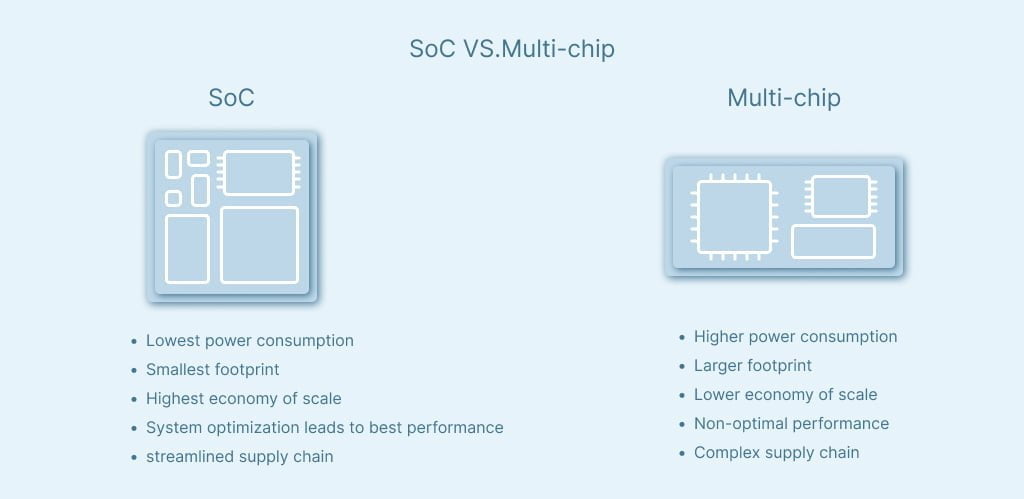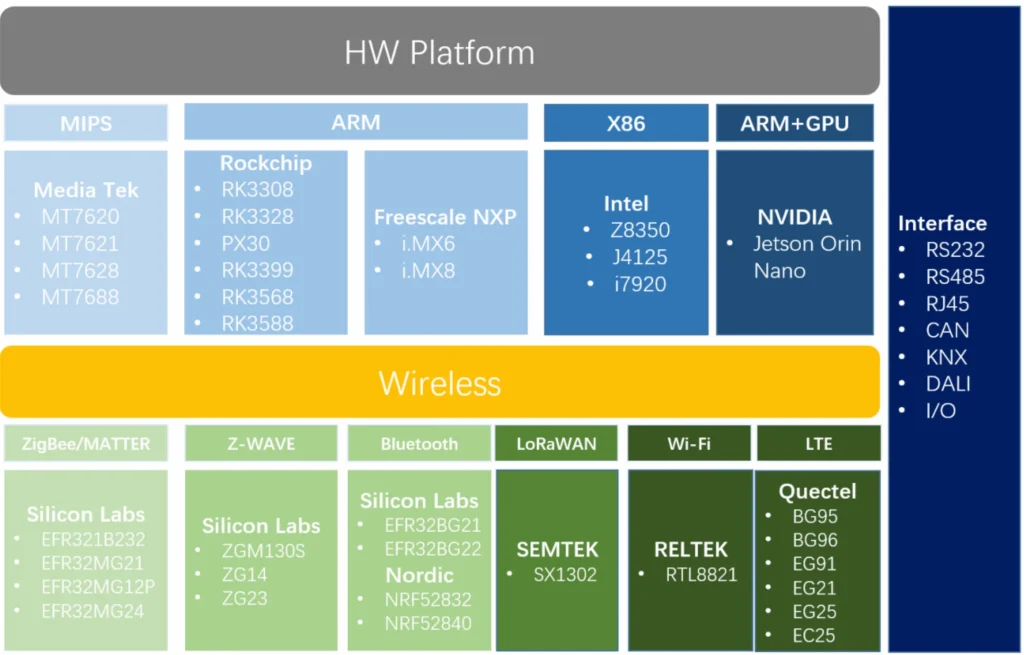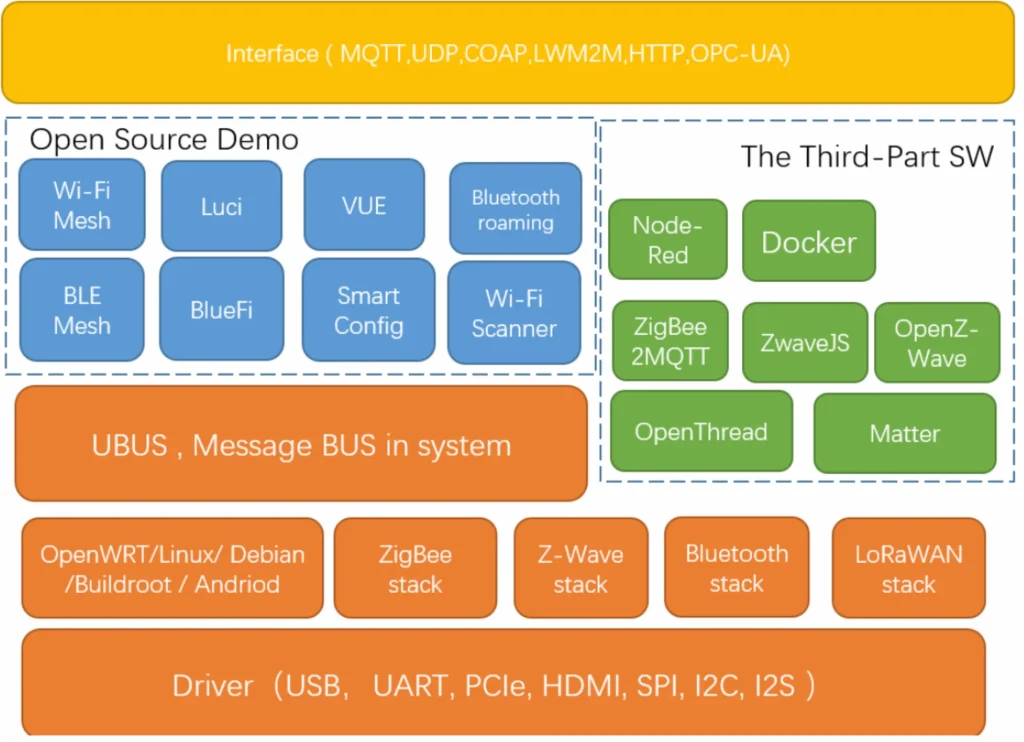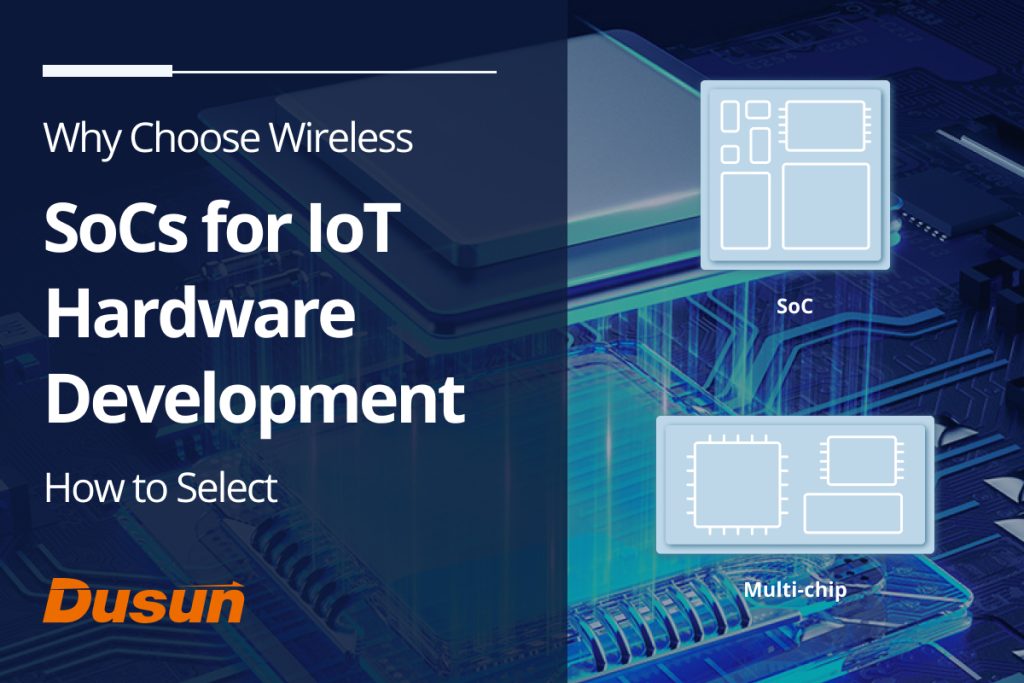SoC offers a level of flexibility, customization, and compartmentalization that traditional implementations lack. Moreover, while SiP, MCM, and discrete-chip implementations can manage complex operational demands well, SoC is built to do so while saving money and energy, particularly when the IoT devices like IoT gateways are deployed on a large scale.
Understanding the benefits of SoC-based IoT Hardware and addressing some of the most important considerations that engineers should make when choosing wireless SoCs for their IoT designs, as well as some of the biggest challenges and tradeoffs.

Dusun offers SoC-Based IoT Hardware with a Full Set of Development Resources for Developers: System on Modules, Motherboards, Programmable IoT Gateways.
What Is SoC?
Short for “system-on-chip,” A SoC is a type of integrated circuit that, in order to save space and improve efficiency, combines the majority of an electronic device’s hardware and software components on a single semiconductor substrate. As an example, SoC may include:
- Microcontroller Unit (MCU): The main controlling module for a product
- RF Module: The component responsible for wireless communication
- Non-volatile Memory: An internal unit that stores program code and other non-volatile system information
- Volatile Memory: Another storage unit used to store temporary code and data
- Digital Signal Processor (DSP): An instrument that aids in receiving and understanding signals from connecting devices and helps the MCU execute complex programming
- Peripheral Ports: Physical points where Ethernet cables, USB drives, and other external devices are connected., can physically connect to an apparatus and communicate with it
- Power Management: A dedicated circuit to manage and optimize the power consumption of different working modes of the SoC
SoCs are flexible enough to be customized to fit applications with their own set of requirements because they are not constrained by specific standards for development.
Why Choose SoC-based Hardware for IoT Development
IoT developers today seek high performance and functionality at a reasonable price. In order to achieve this, the SoC approach has a few significant advantages over the other, less integrated options. The structural requirements of multi-chip implementations, for instance, necessitate extensive supplier sourcing, which raises manufacturing costs above those of SoCs. In order to make sure that all of the components are properly arranged to work together, multi-chip options also require more time during the research and development phase, which further lengthens the time it takes for a product to reach the market. On the other hand, SoC-based devices are much simpler to manufacture from conception to completion because they only need one core to operate, significantly reducing a product’s time to market and preserving battery life that would otherwise be depleted by additional communication between multiple ICs.
How to Select SoC for IoT Gateway Design
For your IoT Gateway or other device design, choosing a wireless system-on-chip (SoC) is difficult. Power consumption, size, and cost are just a few of the variables that need careful consideration. For the IoT application and network, the SoC also needs to support the appropriate wireless protocols, which then involves considerations for things like range, latency, and throughput.
Thinking carefully about your choice of wireless SoCs is one way to make sure that your IoT Gateway or device Development is optimized for the application. Because there will be performance tradeoffs depending on the application, it also necessitates a careful evaluation of the key design requirements, such as battery life, compute and memory resources, and footprint.
When choosing wireless SoCs for their products, designers have a lot of things to take into account.
There is no correct choice in terms of architecture or device because it all depends on the engineering trade-offs that the product designer is willing to make to meet the needs of their target market.
A strong development ecosystem with thorough support tools and services is crucial, according to industry consensus. Designers can cut their time to market and costs with the aid of these tools and services for products and prototyping.
Dusun offers SoC-Based IoT Hardware with a Full Set of Development Resources for Developers: System on Modules, Motherboards, Programmable IoT Gateways.
So let’s address some of the top-of-mind design issues that engineers should consider when selecting wireless SoCs for their IoT designs, as well as some of the biggest challenges and tradeoffs.
Application Dictate SoC Selection
The majority of wireless SoC producers concur that the selection of the wireless SoC is influenced by the application requirements, which also helps to reduce the number of possible designs for IoT device. A host of other factors, including wireless protocols, performance, price, size, tool support, and ease of integration, are also important, but power consumption is one of the most crucial.
The choice of the wireless protocol is determined by the application, even though power consumption is one of the most important factors in choosing wireless SoCs.
For instance, if it’s a battery-powered device, such as a wearable with a single Bluetooth connection, they may choose SoC with ATM33E low energy chip, as power consumption and size and weight are very important and developers must make the decision based on their go-to-market strategy.
Read More: Remote ECG Monitoring
Application dependency can be extended to include aggregation points or Internet of Things gateways, which are places where various heterogeneous wireless networks converge. A higher degree of integration with Bluetooth, Wi-Fi, Zigbee/Thread, etc. would be beneficial for this.
DusunIoT Hardware Solutions for Various Applications
Depending on the application, there are a number of important considerations when choosing a wireless SoC for an IoT device.
The top five factors to take into account are wireless protocols, security, battery life, hardware and software support, including peripherals, GPIOs, IDE support, cloud support, and networking/wireless stack integration, as well as compute and memory resources accessible for the application after the OS, networking stacks, and wireless stacks have been integrated into the wireless SoC.
Next, we discuss some other factors that can help you for choosing SoC-based hardware for IoT project development.
Networking
IoT devices must support multiple protocols, so wireless SoCs offer an integrated solution that streamlines designs by integrating these protocols and handling coexistence issues between multiple protocols on the same ISM band internally. Wireless SoCs also eliminate the need to manage and worry about RF design for multiple devices.
The application throughput, latency, number of network nodes, and range for wireless protocols are all requirements.
The complexity is greatly augmented by adding wireless to IoT devices. IoT devices use a variety of wireless protocols, including Wi-Fi, BT, BLE, Zigbee, Thread, Z-Wave, and cellular. The choice of wireless communication protocols for a particular device depends upon the application, size, cost, power and several other factors
For example, BLE is a good protocol to use for a home-temperature sensor, as it consumes low power, it is lower in cost than some other protocols and it provides the necessary range in a typical home environment.
NFC is best for applications similar to contactless payments because it has the smallest range and lowest throughput. For many applications, including security cameras, Wi-Fi offers the higher application throughput that is required.
So many communication technologies are available and Dusun offers various connectivity hardware solutions for you equipped with a variety of wireless protocols, which can be switched flexibly to meet the different needs of developers, you can choose according to your requirements.
Bluetooth Connectivity
Zigbee Connectivity
Bluetooth Connectivity

Recommended Read:
- Zigbee Vs Z-Wave: Which is Better for Home Automation
- What is the Modbus Protocol and How Does It Work
- Zigbee vs Bluetooth vs Wi-Fi for Smart Homes | Dusun
Software Architecture & OS
Another important factor to take into account when choosing a wireless SoC is the software architecture. The software tools and environment for these SoCs are just as crucial as the hardware, regardless of the product architecture—integrated wireless SoC or discrete. Even without taking into account the complication of choosing which RTOS to utilize from the multitude of options available, whether a device is Linux-based, Android-based, or RTOS-based has a significant impact on the final result. The choice of the operating system will push designers to either use larger, more scalable Linux-based processors or less expensive, RTOS-based microcontrollers.
Dusun SoC based IoT Hardware platform performance varies from low to high, different architecture series of chips MIPS, ARM, X86, ARM+GPU (AI computing power). The working environment level meets the demand of consumer level, industrial level, and vehicle level.

Support multiple open source systems SDKS, OpenWRT, Linux, Debian, Buildroot, Android and multiple language development environments, C, C++, Java.
Recommended:
- Best Operating Systems to Run on IoT Gateway Hardware
- MIPS vs ARM vs X86 vs NPU, The Best Hardware Platform For Your IoT Gateways
Power Consumption
Power consumption is still a crucial consideration, regardless of whether a discrete or integrated solution is used, and it is impacted by the system architecture and use cases. As a result, multi-chip solutions involving separate radio and processor chips might occasionally be simpler to optimize. For certain applications and use cases, wireless processors may in other instances offer all the flexibility required.
For instance, designers will notice the lowest power consumption when using an integrated wireless SoC for straightforward end applications like a sensor or actuator that have a low communications duty cycle and don’t perform any ancillary networking functionality, like routing.
However, a discrete solution might be lower power for more complex devices—like a thermostat, for instance—where packet routing is a crucial component for the end device’s and the target ecosystem’s overall user experience.
Due to our limited power sources, it can occasionally be a serious issue. Numerous factors influence power. Processors that are faster tend to consume more power than those that are slower. We can use sleep mode to use as little power as possible. Actually, the sleep mode might let you use a faster processor to quickly complete tasks before switching back to a low-power sleep.
Processor Speed
This is crucial because one of the factors we considered was processor speed. Your processor’s clock speed, also known as the processor speed, indicates how quickly it can execute each instruction contained in the machine code for the program you are currently running. When a processor is fast, it can actually carry out instructions more quickly.
If the code requires a lot of complex math calculations, a by the numbers slower processor with hardware floating point support may be faster than a slightly higher performance processor without it. This is because some processors may not have hardware support for floating point calculations.
In contrast to CoCs, which operate at hundreds of MHz or GHz, microcontrollers typically operate at speeds in the tens of MHz.
Consequently, you can select a platform based on your requirements. If your project does not require heavyweight processing then some sort of SoCs will have adequate speed.
Ram
Another important factor is RAM. For the system, RAM serves as working memory. Because it depends on your needs, it is challenging to provide precise RAM recommendations. It will differ from one project to the next.
You can choose from a wider range of coding algorithms if you have more RAM. if we are handle large datasets on the device, that could govern how much space you need. Memory constraints are something we run into when writing embedded code. Keep in mind that RAM is the most crucial component.
RAM on microcontrollers is measured in kilobytes, or less than one kilobyte. RAM on SoCs ranges from Megabytes to Gigabytes. The use of SoCs is advised if Linux will be the operating system.
Interfacing With Sensors and Other Circuitry
To communicate with sensors, actuators, and other components, a device needs some interfaces. You could connect to the circuitry using a peripheral bus, the most popular ones being SPI and I2C. To read or write varying voltages, we can use ADC and DAC modules. Digital inputs or outputs that are on or off are provided by a device’s generic GPIO pins.
Different combinations of these interfaces are offered by each SoC in varying numbers.
Support and Availability
Many IoT designers prioritize issues like supply-chain continuity and development and design support, in addition to performance considerations.
The effectiveness with which the product and its development ecosystem can reduce time to market and costs, the accessibility of the product and prototyping tools, and the long-term accessibility of the product are among the main issues.
There are also several questions that designers need to ask, such as if there are guarantees that the SoC will be available as long as their product is in the market, what the roadmap of the SoC is and if it aligns with their product development plan, and if there is sufficient support availability, including for documentation, ecosystem and contact to ensure success
The tradeoff formula includes the need for longevity.
Once a product has shipped, the hardware itself is unchanging; however, there is an expectation from the end customer that the product will continue to be supported and receive updates for some time after their purchase
An increasingly important criterion is choosing a device and a product architecture that enable product designers to deliver updates over the course of the product.
Physical Size and Form Factor :
These days, the size is determined by how many connections it must make to the PCB’s neighboring components. The capabilities and tolerances of your manufacturing process will then set a limit on how small each connection can be. Some surface mount designs can be hand soldered and are large enough for home-etched PCBs. Others need expertly made PCBs and precise pick and place equipment in order to be correctly located.
Many chip designs come in a variety of different packages, or form factors, due to these trade-offs between size and manufacturing complexity. By doing so, the circuit designer is able to select the shape that best suits his particular application.
Due to the physical and potential cost advantages of integrated wireless SoCs, the end-product designer can produce a smaller product or one with a more creative form factor.
Conclusion
Depending on the use cases and the number of wireless protocols it supports, wireless SoC integration can be difficult.
Hardware integration (antenna placement, RF design, etc.) is one of many difficulties, software development (wireless stacks, networking stacks, cloud connectivity, application development), RF testing (including extreme conditions), interoperability testing (with other devices it is supposed to connect to), wireless coexistence (multiple protocols need to co-exist), production testing (minimizing the test time and yield), regulatory certifications (for countries to be supported), protocol compliance (for protocols integrated in the device), power optimization (based on the battery requirements), system security (to ensure device and data security) and solution cost (based on the target).
Designers need to make a tradeoff at every step to optimize between various parameters, and all of these tradeoffs are eventually driven by the application use cases
One of the biggest challenges is figuring out and choosing the appropriate technology that will fit the application and market demand the best. Another challenge is choosing the appropriate hardware (antenna, routing, BOM selection) and matching software, which can vary depending on the technology, while also comprehending the chosen radio protocols.
Optimize Your IoT Landscape with Dusun’s Best-In-Class SoC-Based IoT Hardware
Dusun has designed various IoT Hardware based on various SoC Technology including System on Module, IoT Gateways, Motherboards. Today, DusunIoT’s line of multi-protocol IoT SoCs for IoT Hardware has expanded to include the Rockchip SoCs, MTK SoCs, NXP SoCs, ESP32 SoCs, etc, for affordable, up-to-date, low-energy wireless connectivity.
Partnering with Dusun for your product development goals means investing in the future of IoT. Are you ready to take the next step? Contact us now.
FAQs
What are the advantages of SoC in IoT?
Because all the components are on a single chip and are internally connected, SoCs in general have smaller footprints and space requirements. It is more lightweight if it is smaller in size. Cost-effective SoCs for a given application are possible. At the hardware and firmware levels, SoC offers higher design security.
What is the Difference Between SoC and CPU in IoT?
A GPU (graphics processing unit), memory, USB controller, power management components, and wireless radios are typically included in SoCs in addition to a processor. Because an SoC includes both the hardware and software, it uses less power, has better performance, requires less space and is more reliable than multichip systems.
What Are the Types of System on Chip in IoT?
In general, there are three distinct types of SoCs: SoCs built around microcontrollers; SoCs built around microprocessors, which are frequently found in mobile phones; and Specialized Application-Specific Integrated Circuit SoCs designed for specific applications that do not fit into the above two categories.
What is Wi-Fi SoC?
Wireless SoC Products (System-on-Chips) for Wi-Fi + Bluetooth are chipsets that have been designed speficially for Wi-Fi+Bluetooth applications. In order to provide W-Fi and Bluetooth functionality, these SOCs are used in mobile phones, laptops, access points, and other smart devices.



















